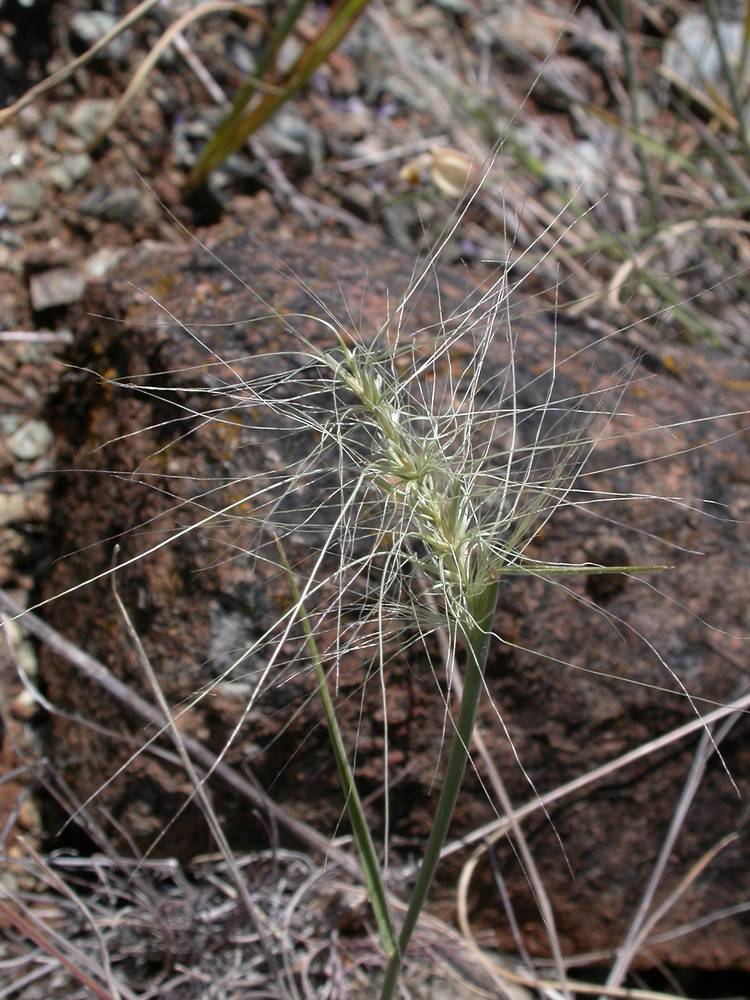
Plants perennial, 15–65 cm tall; cespitose.
Culms erect to ascending.
Leaves sheaths glabrous or white-villous; blades 1.5–4 mm wide; upper surfaces scabrous or hairy.
Inflorescences 5–20 cm, erect, sometimes partially enclosed in the sheath of the uppermost leaf, 2 spikelets per node or rarely 3–4 at some nodes; internodes 3–5(8)mm; disarticulation initially at the rachis nodes, later beneath each floret.
Spikelets 10–15 mm, divergent, 2–4 florets, lowest florets sterile and glume-like in 1 or both spikelets at each node.
Glumes (10)30–100 mm including the awns, the bases hard and glabrous, glume bodies about (2)5–10 × 1–2 mm, setaceous, 2–3-veined; margins firm; glume awns (8)25–90 mm, each split above the base into 3–9 unequal divisions, scabrous, flexuous to outcurving from near the bases at maturity.
Lemmas fertile lemmas 8–10 mm, smooth or scabrous near the tips, 2 lateral veins extending into bristles to 10 mm; lemma awns (10)20– 110 × 0.2 mm at the base, divergent to arching.
Anthers 1–2 mm.
2n=28.
Dry, often rocky grasslands and savannas. 50–2000m. BR, Col, ECas, Lava, Sisk, WV. CA, ID, NV, WA; southeast to CO, south to Mexico. Native.
Elymus multisetus has inflorescences that fall apart at maturity and glumes that are divided into three to nine widely spreading awns. Very similar E. elymoides has glumes that are entire or unevenly split into two to three parts. Determining how much the glumes are split is complicated by the presence of glumelike sterile lemmas in both E. multisetus and some E. elymoides subspecies. Elymus multisetus glumes are divided above the base. If the glumes appear to be divided to the base, the plant is more likely to be E. elymoides.
as described under Elymus multisetus
Plants cespitose, not rhizomatous. Culms 15-65 cm, erect to ascending, usually puberulent; nodes 4-6, mostly concealed, glabrous. Leaves evenly distributed; sheaths glabrous or white-villous; auricles usually present, 0.5-1.5 mm; ligules to 1 mm, truncate, entire or lacerate; blades 1.5-4(5) mm wide, often ascending and involute, adaxial surfaces scabrous, pilose, or villous. Spikes 5-20 cm long, 5-15 cm wide, erect, sometimes partially enclosed at the base, with 2 spikelets per node, rarely with 3-4 at some nodes; internodes 3-5(8) mm long, 0.1-0.3 mm thick at the thinnest sections, glabrous beneath the spikelets. Spikelets 10-15 mm, divergent, with 2-4 florets, lowest florets sterile and glumelike in 1 or both spikelets at each node; disarticulation initially at the rachis nodes, subsequently beneath each floret. Glumes subequal, (10)30-100 mm including the awns, the bases indurate and glabrous, glume bodies about (2)5-10 mm long, 1-2 mm wide, setaceous, 2-3-veined, margins firm, awns (8)25-90 mm, each split into 3-9 unequal divisions, scabrous, flexuous to outcurving from near the glume bases at maturity; fertile lemmas 8-10 mm, smooth or scabrous near the apices, 2 lateral veins extending into bristles to 10 mm, awns (10)20-110 mm long, about 0.2 mm wide at the base, divergent to arcuate; paleas 7-9 mm, veins usually extending into about 1 mm bristles, apices acute to truncate; anthers 1-2 mm. Anthesis from late May to June. 2n = 28.
Elymus multisetus grows in dry, often rocky, open woods and thickets on slopes and plains, from central Washington and Idaho to southern California, Colorado, and northwestern Arizona, and from sea level to 2000 m. It has also been reported from Baja California, Mexico . It usually grows in less arid habitats than E. elymoides subsp. elymoides , but the two taxa are sometimes sympatric.
Wilson (1963) reported a wide belt of introgression between E. multisetus and E. elymoides subsp. elymoides from southeastern California to southern Nevada, but not in other areas where they are sympatric. There are also probable hybrids with Elymus glaucus -and Pseudoroegneria spicata .